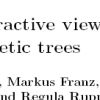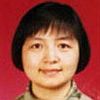| |
     
Daniel H. Huson,
Daniel C. Richter,
Christian Rausch,
Tobias Dezulian,
Markus Franz and
Regula Rupp. Dendroscope: An interactive viewer for large phylogenetic trees. In BMCB, Vol. 8:460, 2007.
Keywords: phylogeny, Program Dendroscope, software, visualization.
Note: http://dx.doi.org/10.1186/1471-2105-8-460, slides available at http://www.newton.cam.ac.uk/webseminars/pg+ws/2007/plg/plgw01/0903/huson/, software freely available from http://www.dendroscope.org.
Toggle abstract
"Background: Research in evolution requires software for visualizing and editing phylogenetic trees, for increasingly very large datasets, such as arise in expression analysis or metagenomics, for example. It would be desirable to have a program that provides these services in an effcient and user-friendly way, and that can be easily installed and run on all major operating systems. Although a large number of tree visualization tools are freely available, some as a part of more comprehensive analysis packages, all have drawbacks in one or more domains. They either lack some of the standard tree visualization techniques or basic graphics and editing features, or they are restricted to small trees containing only tens of thousands of taxa. Moreover, many programs are diffcult to install or are not available for all common operating systems. Results: We have developed a new program, Dendroscope, for the interactive visualization and navigation of phylogenetic trees. The program provides all standard tree visualizations and is optimized to run interactively on trees containing hundreds of thousands of taxa. The program provides tree editing and graphics export capabilities. To support the inspection of large trees, Dendroscope offers a magnification tool. The software is written in Java 1.4 and installers are provided for Linux/Unix, MacOS X and Windows XP. Conclusion: Dendroscope is a user-friendly program for visualizing and navigating phylogenetic trees, for both small and large datasets. © 2007 Huson et al; licensee BioMed Central Ltd."
|
|
| |

Daniel H. Huson. Drawing Rooted Phylogenetic Networks. In TCBB, Vol. 6(1):103-109, 2009.
Keywords: explicit network, phylogenetic network, phylogeny, Program Dendroscope, Program SplitsTree, visualization.
Note: http://dx.doi.org/10.1109/TCBB.2008.58.
Toggle abstract
"The evolutionary history of a collection of species is usually represented by a phylogenetic tree. Sometimes, phylogenetic networks are used as a means of representing reticulate evolution or of showing uncertainty and incompatibilities in evolutionary datasets. This is often done using unrooted phylogenetic networks such as split networks, due in part, to the availability of software (SplitsTree) for their computation and visualization. In this paper we discuss the problem of drawing rooted phylogenetic networks as cladograms or phylograms in a number of different views that are commonly used for rooted trees. Implementations of the algorithms are available in new releases of the Dendroscope and SplitsTree programs. © 2006 IEEE."
|
|
| |
  
Gabriel Cardona,
Francesc Rosselló and
Gabriel Valiente. Extended Newick: It is Time for a Standard Representation. In BMCB, Vol. 9:532, 2008.
Keywords: evaluation, explicit network, phylogenetic network, Program Bio PhyloNetwork, Program Dendroscope, Program NetGen, Program PhyloNet, Program SplitsTree, Program TCS, visualization.
Note: http://bioinfo.uib.es/media/uploaded/bmc-2008-enewick-sub.pdf.
|
|
| |

Robert G. Beiko. Gene sharing and genome evolution: networks in trees and trees in networks. In Biology and Philosophy, Vol. 25(4):659-673, 2010.
Keywords: abstract network, explicit network, from rooted trees, galled network, phylogenetic network, phylogeny, Program Dendroscope, Program SplitsTree, reconstruction, split network, survey.
Note: http://dx.doi.org/10.1007/s10539-010-9217-3.
Toggle abstract
"Frequent lateral genetic transfer undermines the existence of a unique "tree of life" that relates all organisms. Vertical inheritance is nonetheless of vital interest in the study of microbial evolution, and knowing the "tree of cells" can yield insights into ecological continuity, the rates of change of different cellular characters, and the evolutionary plasticity of genomes. Notwithstanding within-species recombination, the relationships most frequently recovered from genomic data at shallow to moderate taxonomic depths are likely to reflect cellular inheritance. At the same time, it is clear that several types of 'average signals' from whole genomes can be highly misleading, and the existence of a central tendency must not be taken as prima facie evidence of vertical descent. Phylogenetic networks offer an attractive solution, since they can be formulated in ways that mitigate the misleading aspects of hybrid evolutionary signals in genomes. But the connections in a network typically show genetic relatedness without distinguishing between vertical and lateral inheritance of genetic material. The solution may lie in a compromise between strict tree-thinking and network paradigms: build a phylogenetic network, but identify the set of connections in the network that are potentially due to vertical descent. Even if a single tree cannot be unambiguously identified, choosing a subnetwork of putative vertical connections can still lead to drastic reductions in the set of candidate vertical hypotheses. © 2010 Springer Science+Business Media B.V."
|
|
| |
  
Celine Scornavacca,
Simone Linz and
Benjamin Albrecht. A fi�rst step towards computing all hybridization networks for two rooted binary phylogenetic trees. In JCB, Vol. 19:1227-1242, 2012.
Keywords: agreement forest, explicit network, FPT, from rooted trees, phylogenetic network, phylogeny, Program Dendroscope, Program Hybroscale, reconstruction.
Note: http://arxiv.org/abs/1109.3268.
Toggle abstract
"Recently, considerable effort has been put into developing fast algorithms to reconstruct a rooted phylogenetic network that explains two rooted phylogenetic trees and has a minimum number of hybridization vertices. With the standard app1235roach to tackle this problem being combinatorial, the reconstructed network is rarely unique. From a biological point of view, it is therefore of importance to not only compute one network, but all possible networks. In this article, we make a first step toward approaching this goal by presenting the first algorithm-called allMAAFs-that calculates all maximum-acyclic-agreement forests for two rooted binary phylogenetic trees on the same set of taxa. © Copyright 2012, Mary Ann Liebert, Inc. 2012."
|
|
| |
   
Benjamin Albrecht,
Celine Scornavacca,
Alberto Cenci and
Daniel H. Huson. Fast computation of minimum hybridization networks. In BIO, Vol. 28(2):191-197, 2012.
Keywords: explicit network, from rooted trees, minimum number, phylogenetic network, phylogeny, Program Dendroscope, Program Hybroscale, reconstruction.
Note: http://dx.doi.org/10.1093/bioinformatics/btr618.
Toggle abstract
"Motivation: Hybridization events in evolution may lead to incongruent gene trees. One approach to determining possible interspecific hybridization events is to compute a hybridization network that attempts to reconcile incongruent gene trees using a minimum number of hybridization events. Results: We describe how to compute a representative set of minimum hybridization networks for two given bifurcating input trees, using a parallel algorithm and provide a user-friendly implementation. A simulation study suggests that our program performs significantly better than existing software on biologically relevant data. Finally, we demonstrate the application of such methods in the context of the evolution of the Aegilops/Triticum genera. Availability and implementation: The algorithm is implemented in the program Dendroscope 3, which is freely available from www.dendroscope.org and runs on all three major operating systems. © The Author 2011. Published by Oxford University Press. All rights reserved."
|
|
| |
 
Daniel H. Huson and
Celine Scornavacca. Dendroscope 3: An Interactive Tool for Rooted Phylogenetic Trees and Networks. In Systematic Biology, Vol. 61(6):1061-1067, 2012.
Keywords: from rooted trees, from triplets, phylogenetic network, phylogeny, Program Dendroscope, reconstruction, software, visualization.
Toggle abstract
"Dendroscope 3 is a new program for working with rooted phylogenetic trees and networks. It provides a number of methods for drawing and comparing rooted phylogenetic networks, and for computing them from rooted trees. The program can be used interactively or in command-line mode. The program is written in Java, use of the software is free, and installers for all 3 major operating systems can be downloaded from www.dendroscope.org. [Phylogenetic trees; phylogenetic networks; software.] © 2012 The Author(s)."
|
|
| |
   
Juan Wang,
Maozu Guo,
Linlin Xing,
Kai Che,
Xiaoyan Liu and
Chunyu Wang. BIMLR: A Method for Constructing Rooted Phylogenetic Networks from Rooted Phylogenetic Trees. In Gene, Vol. 527(1):344-351, 2013.
Keywords: explicit network, from clusters, from rooted trees, phylogenetic network, phylogeny, Program BIMLR, Program Dendroscope, reconstruction, software.
Toggle abstract
"Rooted phylogenetic trees constructed from different datasets (e.g. from different genes) are often conflicting with one another, i.e. they cannot be integrated into a single phylogenetic tree. Phylogenetic networks have become an important tool in molecular evolution, and rooted phylogenetic networks are able to represent conflicting rooted phylogenetic trees. Hence, the development of appropriate methods to compute rooted phylogenetic networks from rooted phylogenetic trees has attracted considerable research interest of late. The CASS algorithm proposed by van Iersel et al. is able to construct much simpler networks than other available methods, but it is extremely slow, and the networks it constructs are dependent on the order of the input data. Here, we introduce an improved CASS algorithm, BIMLR. We show that BIMLR is faster than CASS and less dependent on the input data order. Moreover, BIMLR is able to construct much simpler networks than almost all other methods. BIMLR is available at http://nclab.hit.edu.cn/wangjuan/BIMLR/. © 2013 Elsevier B.V."
|
|
| |
|
| |

Juan Wang. A Survey of Methods for Constructing Rooted Phylogenetic Networks. In PLoS ONE, Vol. 11(11):e0165834, 2016.
Keywords: evaluation, explicit network, from clusters, phylogenetic network, phylogeny, Program BIMLR, Program Dendroscope, Program LNetwork, reconstruction, survey.
Note: http://dx.doi.org/10.1371/journal.pone.0165834.
|
|
|
|
| |
 
Daniel H. Huson and
Regula Rupp. Summarizing Multiple Gene Trees Using Cluster Networks. In WABI08, Vol. 5251:296-305 of LNCS, springer, 2008.
Keywords: abstract network, from clusters, from rooted trees, phylogenetic network, phylogeny, polynomial, Program Dendroscope.
Note: http://dx.doi.org/10.1007/978-3-540-87361-7_25, slides from the MIEP Conference available at http://www.lirmm.fr/MIEP08/slides/11_13_rupp.pdf.
Toggle abstract
"The result of a multiple gene tree analysis is usually a number of different tree topologies that are each supported by a significant proportion of the genes. We introduce the concept of a cluster network that can be used to combine such trees into a single rooted network, which can be drawn either as a cladogram or phylogram. In contrast to split networks, which can grow exponentially in the size of the input, cluster networks grow only quadratically. A cluster network is easily computed using a modification of the tree-popping algorithm, which we call network-popping. The approach has been implemented as part of the Dendroscope tree-drawing program and its application is illustrated using data and results from three recent studies on large numbers of gene trees. © 2008 Springer-Verlag Berlin Heidelberg."
|
|
| |
    
Daniel H. Huson,
Regula Rupp,
Vincent Berry,
Philippe Gambette and
Christophe Paul. Computing Galled Networks from Real Data. In ISMBECCB09, Vol. 25(12):i85-i93 of BIO, 2009.
Keywords: abstract network, cluster containment, explicit network, FPT, from clusters, from rooted trees, galled network, NP complete, phylogenetic network, phylogeny, polynomial, Program Dendroscope, reconstruction.
Note: http://hal-lirmm.ccsd.cnrs.fr/lirmm-00368545/en/.
Toggle abstract
"Motivation: Developing methods for computing phylogenetic networks from biological data is an important problem posed by molecular evolution and much work is currently being undertaken in this area. Although promising approaches exist, there are no tools available that biologists could easily and routinely use to compute rooted phylogenetic networks on real datasets containing tens or hundreds of taxa. Biologists are interested in clades, i.e. groups of monophyletic taxa, and these are usually represented by clusters in a rooted phylogenetic tree. The problem of computing an optimal rooted phylogenetic network from a set of clusters, is hard, in general. Indeed, even the problem of just determining whether a given network contains a given cluster is hard. Hence, some researchers have focused on topologically restricted classes of networks, such as galled trees and level-k networks, that are more tractable, but have the practical draw-back that a given set of clusters will usually not possess such a representation. Results: In this article, we argue that galled networks (a generalization of galled trees) provide a good trade-off between level of generality and tractability. Any set of clusters can be represented by some galled network and the question whether a cluster is contained in such a network is easy to solve. Although the computation of an optimal galled network involves successively solving instances of two different NP-complete problems, in practice our algorithm solves this problem exactly on large datasets containing hundreds of taxa and many reticulations in seconds, as illustrated by a dataset containing 279 prokaryotes. © 2009 The Author(s)."
|
|
| |
   
Leo van Iersel,
Steven Kelk,
Regula Rupp and
Daniel H. Huson. Phylogenetic Networks Do not Need to Be Complex: Using Fewer Reticulations to Represent Conflicting Clusters. In ISMB10, Vol. 26(12):i124-i131 of BIO, 2010.
Keywords: from clusters, level k phylogenetic network, Program Dendroscope, Program HybridInterleave, Program HybridNumber, reconstruction.
Note: http://dx.doi.org/10.1093/bioinformatics/btq202, with proofs: http://arxiv.org/abs/0910.3082.
Toggle abstract
"Phylogenetic trees are widely used to display estimates of how groups of species are evolved. Each phylogenetic tree can be seen as a collection of clusters, subgroups of the species that evolved from a common ancestor. When phylogenetic trees are obtained for several datasets (e.g. for different genes), then their clusters are often contradicting. Consequently, the set of all clusters of such a dataset cannot be combined into a single phylogenetic tree. Phylogenetic networks are a generalization of phylogenetic trees that can be used to display more complex evolutionary histories, including reticulate events, such as hybridizations, recombinations and horizontal gene transfers. Here, we present the new CASS algorithm that can combine any set of clusters into a phylogenetic network. We show that the networks constructed by CASS are usually simpler than networks constructed by other available methods. Moreover, we show that CASS is guaranteed to produce a network with at most two reticulations per biconnected component, whenever such a network exists. We have implemented CASS and integrated it into the freely available Dendroscope software. Contact: l.j.j.v.iersel@gmail.com. Supplementary information: Supplementary data are available at Bioinformatics online. © The Author(s) 2010. Published by Oxford University Press."
|
|
| |
 
Celine Scornavacca,
Franziska Zickmann and
Daniel H. Huson. Tanglegrams for Rooted Phylogenetic Trees and Networks. In ISMB11, Vol. 27(13):i248-i256 of BIO, 2011.
Keywords: from network, heuristic, integer linear programming, phylogenetic network, phylogeny, Program Dendroscope, tanglegram, visualization.
Note: http://dx.doi.org/10.1093/bioinformatics/btr210.
Toggle abstract
"Motivation: In systematic biology, one is often faced with the task of comparing different phylogenetic trees, in particular in multi-gene analysis or cospeciation studies. One approach is to use a tanglegram in which two rooted phylogenetic trees are drawn opposite each other, using auxiliary lines to connect matching taxa. There is an increasing interest in using rooted phylogenetic networks to represent evolutionary history, so as to explicitly represent reticulate events, such as horizontal gene transfer, hybridization or reassortment. Thus, the question arises how to define and compute a tanglegram for such networks. Results: In this article, we present the first formal definition of a tanglegram for rooted phylogenetic networks and present a heuristic approach for computing one, called the NN-tanglegram method. We compare the performance of our method with existing tree tanglegram algorithms and also show a typical application to real biological datasets. For maximum usability, the algorithm does not require that the trees or networks are bifurcating or bicombining, or that they are on identical taxon sets. © The Author(s) 2011. Published by Oxford University Press."
|
|
| |
   
Leo van Iersel,
Steven Kelk,
Nela Lekic and
Celine Scornavacca. A practical approximation algorithm for solving massive instances of hybridization number. In WABI12, Vol. 7534(430-440) of LNCS, springer, 2012.
Keywords: agreement forest, approximation, explicit network, from rooted trees, hybridization, phylogenetic network, phylogeny, Program CycleKiller, Program Dendroscope, Program HybridNET, reconstruction, software.
Note: http://arxiv.org/abs/1205.3417.
Toggle abstract
"Reticulate events play an important role in determining evolutionary relationships. The problem of computing the minimum number of such events to explain discordance between two phylogenetic trees is a hard computational problem. In practice, exact solvers struggle to solve instances with reticulation number larger than 40. For such instances, one has to resort to heuristics and approximation algorithms. Here we present the algorithm CycleKiller which is the first approximation algorithm that can produce solutions verifiably close to optimality for instances with hundreds or even thousands of reticulations. Theoretically, the algorithm is an exponential-time 2-approximation (or 4-approximation in its fastest mode). However, using simulations we demonstrate that in practice the algorithm runs quickly for large and difficult instances, producing solutions within one percent of optimality. An implementation of this algorithm, which extends the theoretical work of [14], has been made publicly available. © 2012 Springer-Verlag."
|
|
|
|
 - forked on GitHub.
- forked on GitHub.

























